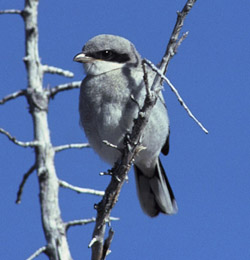Loggerhead Shrike
|
|
| Loggerhead Shrike | ||||||||||||||
|---|---|---|---|---|---|---|---|---|---|---|---|---|---|---|
 | ||||||||||||||
| Scientific classification | ||||||||||||||
| ||||||||||||||
| Binomial name | ||||||||||||||
| Lanius ludovicianus Linnaeus, 1766 |
The Loggerhead Shrike (Lanius ludovicianus) is a passerine bird of the shrike family.
These birds have a large hooked bill; the head and back are grey with white underparts. They have black wings and tail, with white patches on the wings and white on the outer tail feather. Unlike the similar but slightly larger Northern Shrike, the black face mask extends over the bill.
Their breeding habitat is semi-open areas in southern Ontario, Quebec and Alberta, south to Mexico. They nest in a dense tree or shrub. The female lays 4 to 8 eggs in a bulky cup built from twigs and grass.
They are permanent residents in the southern part of their range; northern birds migrate further south.
These birds wait on a perch with open lines of sight and swoop down to capture prey. They mainly eat large insects, also rodents and small birds. They impale their prey on thorns or barbed wire before eating it, since they do not have the talons of the larger birds of prey.
The population of this species has declined in the northeastern parts of their range, possibly due to loss of suitable habitat and pesticide use.
"Loggerhead" refers to the relatively large head as compared to the rest of the body.
